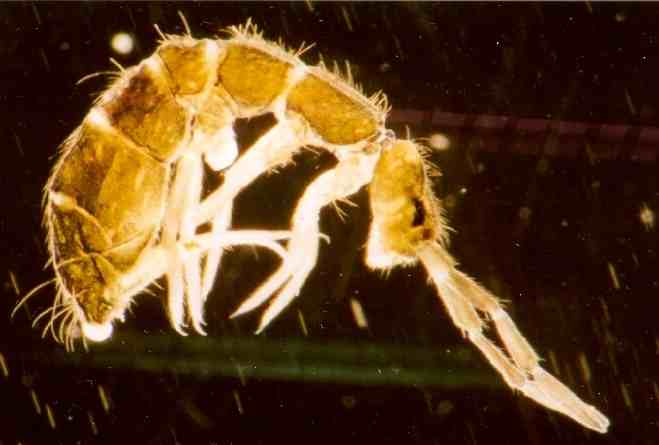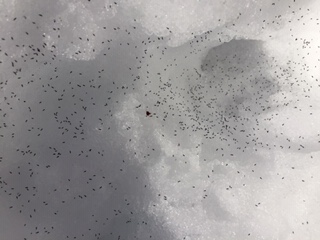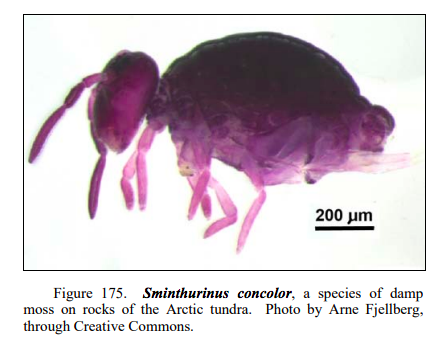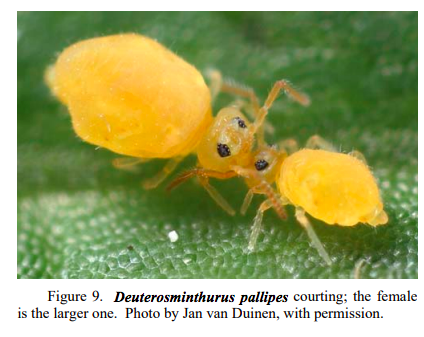This picture came from a colleague, C, with a question- what are these tiny black dots all over the snow? They look like they jump.
So, on the off chance you want to know, here is an answer in two snack-sized pieces:
These tiny dots, the size of about a poppy seed, are omnivorous animals that eat tiny microbes and break up minuscule bits of leaf litter. They are in a group called “collembolans” or “springtails”. The springtails are one of the most common animal groups on the planet.
While they have the three body segments, an exoskeleton, and six legs, collembolans are not considered true insects, but an insect wanna-be, a close relative. There are two other six-legged groups that are not insects but are still in the larger group that contains insects, the”Hexapoda”. Members of the other two almost insect-groups are also tiny and live in leaf litter and soil. You are very unlikely to have run across species of either of these tiny soil dwellers.
While small, collembolans are the most obvious of the three non-insect hexapods. Sometimes they can be seen in large numbers on the surface of water, held up by surface tension. I and my students see them most often just the way C and his family did- in large groups on the surface of snow on sunny winter days in the woods. In general, they require dampness and many live in mossy habitats. They can get into damp parts of buildings but are not known to harm humans or materials.
This is a good stopping point if all you needed was a snack of information.
Below is not a whole informational meal, but a second, snack, with more protein:
 (from U. Burkhardt, under a Creative Commons license):https://en.wikipedia.org/wiki/File:Isotoma_Habitus.jpg
(from U. Burkhardt, under a Creative Commons license):https://en.wikipedia.org/wiki/File:Isotoma_Habitus.jpg
The collembolan in this picture is 3.5 mm long, about 1/8 inch.
Notice a bump on the underside between the second and third pairs of legs. This is the collophore- a structure that gives Collembola its name. People used to think it was for physical balance but now the thinking is that the collophore somehow works to regulate water balance and is possibly used to obtain oxygen as well.
Now notice another structure that juts out from the tip of the abdomen, up towards the legs and outward. This collembolan furcula is used in locomotion and allows them to spring quite high suddenly (thus “spring tail”). This spring loaded structure can propel them upward as much as 15-20 times their height. (For me that would be jumping as much as 88-118 ft.) Cool beans, now I know what I want my super power to be!
Most collembolans are elongated like this one above, but other species are globular. To me globular springtails are pretty darn cute when seen up close:)
This globular springtail is not from MA but this photo is a great microscope image that lets you see the furcula. from:https://digitalcommons.mtu.edu/cgi/viewcontent.cgi?referer=https://www.google.com/&httpsredir=1&article=1151&context=bryo-ecol-subchapters
Because they are epically fabulous, some collembolan species can reproduce without fertilization. In other species, males produce spermatophores (sperm packets), placed in the habitat, with which females inseminate themselves. This process may involve males simply placing spermatophores all around their mossy patch, hoping females will find it, or engaging in several kinds of courtship rituals in which a male entices a female to accept his spermatophore.
I know how much you need this picture; here are two courting collembolans (from the same source as above):
That’s all our information on micro-life for the day. It might have actually been a meal. Sorry about that. I hope you are able to go out and see some tiny creatures too.



